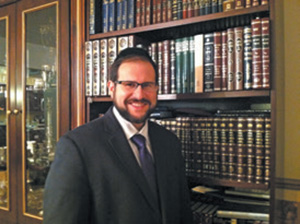

Many people feel their lives are spinning aimlessly, without going anywhere. Someone recently made a living model of that experience, patented and marketed it, and is now raking it in. Perhaps you have seen some of them on the tips of people’s fingers—they are called fidget spinners. During the past few weeks there has been an absolute craze for fidget spinners, or, as I like to more accurately call them, fidget enhancement spinners.
It’s always helpful to market a toy as something that can help people maintain attention. The fact that there is no empirical evidence to back it up doesn’t seem to matter. In fact, every teacher can attest that the only thing fidget spinners do is make spinning noises while students play with them and not pay attention during class. In my classroom, I have outlawed them. Friends have told me that fidget spinners have spread to the workplace, and that adults are using them as much as children.
To be fair, fidget spinners are extremely beneficial—to those who have been manufacturing and selling them. To be honest, they are fun to play with. But don’t let anyone fool you into thinking that they help with concentration.
I am confident that the spinner craze will pass, and they will go the way of diablos, Crazy Bones, Rubik’s Cubes and Silly Bandz. But until then, they serve as a great reminder of what life can become when devoid of direction or meaning.
The Jewish year is compared to a circle. Rav Shimshon Pincus, zt”l, explains that the year is a cycle of growth. It begins with our national birth on Pesach, continues with our national entry into mitzvot (bar/bat mitzvah) on Shavuot and reaches its crescendo with our national union/marriage to God on Sukkot. [The sukkah is analogous to the chupah, and Shemini Atzeret is analogous to the greatest level of intimacy with Hashem, as it were.] Prior to marriage, one’s sins are forgiven, symbolized by Rosh Hashanah and Yom Kippur.
Rav Pincus further explains that even after a wedding, we cannot yet be confident that the marriage will endure. It’s only when the loyalty of husband and wife have been seriously tested, and the marriage was able to emerge intact, or even strengthened, that we can be confident that it is a strong and lasting union.
That is essentially what transpired on Chanukah and Purim. Our national loyalty was severely tested under harrowing conditions. When we proved that our sole loyalty was to Hashem, redemption occurred.
I recently heard a very moving lecture from Mrs. Tzipi Caton, in which she shared her experiences with having and overcoming cancer as a teenager. She related that when she was first diagnosed, there was an older girl in her school who was already in remission from the same cancer. That girl came with her parents to visit Mrs. Caton to give her chizuk. Mrs. Caton asked the older girl if she had any pictures from that time period so she could have an idea of what she should expect. The girl’s father replied that those were six months they were trying to forget, and they definitely did not have any pictures from then. Mrs. Caton noted that she and her family took the opposite approach; they took pictures of everything. She reasoned that if this was an experience she had to undergo, she was going to embrace it and was not going to try to just forget about it.
It’s a very poignant point, and one we all need to remember. In life, we should never seek to shut the door on past experiences, even negative ones, and even severe failings on our part. We will anyway be unable to do so, because we can’t escape our past. Like it or not, it’s part of our reality. Rather, the goal is to use it as a stepping stone for our personal growth and to help others. Successful people use the failings in their past for current growth and future inspiration.
Chanukah and Purim are celebratory holidays because we were able to transform terrible experiences into stepping stones for national inspiration and growth.
At present, Tisha B’Av and the other fast days remain days of pain and tears because we have not yet been able to sufficiently learn their lessons, to transform them into days of inspiration and growth. When we finally do understand their messages, they will indeed be transformed and will also become yomim tovim.
Rav Zev Leff notes that the Jewish year is not a circle, but a spiral. The goal is that with each year, when we return to that point on the circle, we are not on the same level as we were the year prior, but have reached new levels of growth. It’s the same time period, but we have progressed to greater heights.
So, life is not like a fidget spinner, which spins aimlessly, or at least ought not be.
Perhaps someone can patent a “spiral spinner,” which spins upward like an upside-down slinky. It can be advertised as a device that helps promote spiritual growth.
Just remember to send me royalties for the idea.
By Rabbi Dani Staum
Rabbi Dani Staum, LMSW, is the rabbi of Kehillat New Hempstead as well as guidance counselor and seventh-grade rebbe in ASHAR, principal at Mesivta Ohr Naftoli of New Windsor and a division head at Camp Dora Golding. He also presents parenting classes based on the acclaimed Love and Logic methods. His email address is: stamtorah@gmail.com. His website is: www.stamtorah.info.












